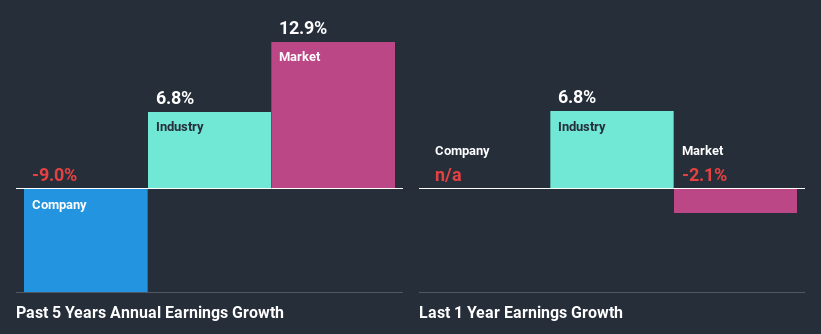- United States
- /
- Electric Utilities
- /
- NasdaqGS:VIA
Spark Energy, Inc.'s (NASDAQ:SPKE) Stock Has Seen Strong Momentum: Does That Call For Deeper Study Of Its Financial Prospects?
Spark Energy's (NASDAQ:SPKE) stock is up by a considerable 24% over the past three months. Given that stock prices are usually aligned with a company's financial performance in the long-term, we decided to study its financial indicators more closely to see if they had a hand to play in the recent price move. Specifically, we decided to study Spark Energy's ROE in this article.
ROE or return on equity is a useful tool to assess how effectively a company can generate returns on the investment it received from its shareholders. In simpler terms, it measures the profitability of a company in relation to shareholder's equity.
See our latest analysis for Spark Energy
How Do You Calculate Return On Equity?
The formula for return on equity is:
Return on Equity = Net Profit (from continuing operations) ÷ Shareholders' Equity
So, based on the above formula, the ROE for Spark Energy is:
44% = US$74m ÷ US$169m (Based on the trailing twelve months to June 2020).
The 'return' refers to a company's earnings over the last year. So, this means that for every $1 of its shareholder's investments, the company generates a profit of $0.44.
What Is The Relationship Between ROE And Earnings Growth?
Thus far, we have learned that ROE measures how efficiently a company is generating its profits. Depending on how much of these profits the company reinvests or "retains", and how effectively it does so, we are then able to assess a company’s earnings growth potential. Assuming everything else remains unchanged, the higher the ROE and profit retention, the higher the growth rate of a company compared to companies that don't necessarily bear these characteristics.
Spark Energy's Earnings Growth And 44% ROE
To begin with, Spark Energy has a pretty high ROE which is interesting. Secondly, even when compared to the industry average of 9.3% the company's ROE is quite impressive. As you might expect, the 9.0% net income decline reported by Spark Energy doesn't bode well with us. So, there might be some other aspects that could explain this. These include low earnings retention or poor allocation of capital.
However, when we compared Spark Energy's growth with the industry we found that while the company's earnings have been shrinking, the industry has seen an earnings growth of 6.8% in the same period. This is quite worrisome.

Earnings growth is a huge factor in stock valuation. It’s important for an investor to know whether the market has priced in the company's expected earnings growth (or decline). Doing so will help them establish if the stock's future looks promising or ominous. One good indicator of expected earnings growth is the P/E ratio which determines the price the market is willing to pay for a stock based on its earnings prospects. So, you may want to check if Spark Energy is trading on a high P/E or a low P/E, relative to its industry.
Is Spark Energy Using Its Retained Earnings Effectively?
Spark Energy has a high three-year median payout ratio of 87% (that is, it is retaining 13% of its profits). This suggests that the company is paying most of its profits as dividends to its shareholders. This goes some way in explaining why its earnings have been shrinking. With only a little being reinvested into the business, earnings growth would obviously be low or non-existent. Our risks dashboard should have the 3 risks we have identified for Spark Energy.
In addition, Spark Energy has been paying dividends over a period of six years suggesting that keeping up dividend payments is preferred by the management even though earnings have been in decline.
Conclusion
In total, it does look like Spark Energy has some positive aspects to its business. However, while the company does have a high ROE, its earnings growth number is quite disappointing. This can be blamed on the fact that it reinvests only a small portion of its profits and pays out the rest as dividends. Up till now, we've only made a short study of the company's growth data. To gain further insights into Spark Energy's past profit growth, check out this visualization of past earnings, revenue and cash flows.
If you decide to trade Spark Energy, use the lowest-cost* platform that is rated #1 Overall by Barron’s, Interactive Brokers. Trade stocks, options, futures, forex, bonds and funds on 135 markets, all from a single integrated account. Promoted
New: Manage All Your Stock Portfolios in One Place
We've created the ultimate portfolio companion for stock investors, and it's free.
• Connect an unlimited number of Portfolios and see your total in one currency
• Be alerted to new Warning Signs or Risks via email or mobile
• Track the Fair Value of your stocks
This article by Simply Wall St is general in nature. It does not constitute a recommendation to buy or sell any stock, and does not take account of your objectives, or your financial situation. We aim to bring you long-term focused analysis driven by fundamental data. Note that our analysis may not factor in the latest price-sensitive company announcements or qualitative material. Simply Wall St has no position in any stocks mentioned.
*Interactive Brokers Rated Lowest Cost Broker by StockBrokers.com Annual Online Review 2020
Have feedback on this article? Concerned about the content? Get in touch with us directly. Alternatively, email editorial-team@simplywallst.com.
About NasdaqGS:VIA
Via Renewables
Through its subsidiaries, operates as an independent retail energy services company in the United States.
Flawless balance sheet and good value.
Similar Companies
Market Insights
Community Narratives



